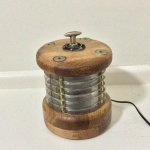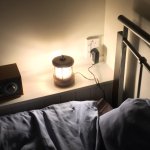finally my new Mean Well PCD-40-700B arrived.
i can see some change of the light. it seems to be calmer.
also my old voltmeter broke so i did buy a new one and this one is capable of measuring HZ.
DC output when powering the lamp.
old supply: 12-13kHZ
new supply: ~7kHZ
not sure what frequency is better for the eye/brain...
anyway without an osciloscope it is hard to tell..
i can see some change of the light. it seems to be calmer.
also my old voltmeter broke so i did buy a new one and this one is capable of measuring HZ.
DC output when powering the lamp.
old supply: 12-13kHZ
new supply: ~7kHZ
not sure what frequency is better for the eye/brain...
anyway without an osciloscope it is hard to tell..
Our eyes are quite slow compared to the frequencies you mention....12-13kHz...7 kHz...not sure what frequency is better for the eye/brain...
Back in the days of CRT computer monitors, few people complained about flicker once it became possible to raise the vertical scan frequency to above 150 Hz or so. Movies are made at 24 frames per second, but each frame is shown two or three times, for a display frequency of 48 or 72 Hz. Old-fashioned fluorescent lights flickered at 100 Hz in countries with 50 Hz AC, and at 120 Hz in countries with 60 Hz AC. Both were noticeable, and often annoying.
But once you get above, say, 200 Hz, it is very unlikely that you can detect any flicker. Your 7 kHz power supply has a frequency thirty-five times higher than that, so there is pretty much zero chance of the human eye/brain detecting any flicker from LEDs powered by it.
-Gnobuddy
I'm just glad you didn't try to smooth out the first one with a big capacitor -- it wouldn't work. Worse, it would almost certainly have confounded the regulation loop; and if that wasn't bad enough, odds are that it would kill the output device.
Good on ya', Rick
Good on ya', Rick
Last edited:
nah i then watched the video and learned that i have to enlarge the one on output.I'm just glad you didn't try to smooth out the first one with a big capacitor -- it wouldn't work. Worse, it would almost certainly have confounded the regulation loop; and if that wasn't bad enough, odds are that it would kill the output device.
Good on ya', Rick
@Gnobuddy: anyway my neuronal network does not work well at 7kHz so i switched back to the previous 13kHz.
it is not about the eye frequency but also about your brain. and that stuff might response even to what the eye can not see.
Small thread deviation - I built this a while back from hardrive discs perspex sheets and a 12volt LED bulb and holder and hardwood from a broken toilet seat. Rotary switch from vintage wire and supply. It's powered from 12volt wall wart. The problem is it creates lots of RF interference and it's impossible to listen to the radio nearby when the lamp is on. Is it the bulb causing problems or the power supply?




I doubt that very much. The brain only receives signals sent by the optic nerves, and nerves are quite slow - they cannot respond at kilohertz frequencies. If the eye doesn't respond, it's not sending signals to the brain, so the brain can't respond, either.it is not about the eye frequency but also about your brain. and that stuff might response even to what the eye can not see.
However: just yesterday, I saw a set of LED lights flickering badly at the cafeteria where I bought my lunch. This is the first time I've seen LED lights flicker during normal operation. And I thought of this thread.
The flicker frequency was quite low, low enough that I could estimate it by tapping my palm with one of two fingertips each time the light brightened. By this crude technique I estimated the flicker frequency was in the neighbourhood of 10 Hz. (Not kilohertz , just plain old hertz.)
This is very low, far below the switching frequency of the power supply, which is bound to be many kilohertz. And such a low frequency is well within the eye's capability to detect it.
Without being able to study the electronics, I don't know what was causing the 10 Hz flicker. Perhaps a poorly designed current regulation feedback loop that is unstable and oscillating at 10 Hz. But that's just a guess.
-Gnobuddy
> Is it the bulb causing problems or the power supply?
Yes.
Either, or maybe both, or just both together.
The wart is a switcher and these tend to spew RF. The better ones spew less; I don't suppose you have an alternate?
If it is 12V DC, take the battery (zero RFI) out of your lawn tractor and try it. (Yes, your car has a 12V batt but recent cars get very upset by battery removal.) (However you could take the lamp to the car, jumpered from the cigar lighter, and see if it messes the car radio.)
There are no 12V LEDs. A passive resistor dropper is unfashionably wasteful. So there is probably another switcher inside the LED assembly. This can throw hash.
The two switchers, not designed for each other, may have frequencies which mix to sum and difference tones, and they are very likely to spray all up and down the radio band.
Test the wart alone.
Test the lamp by putting it on a cookie-sheet and putting a pasta-pot over it. This won't kill all RFI, but it may be enough of a change to show the lamp is a major player. (If the actual bulb is small, put it in a soup-can and cover the top with kitchen foil wrapped snug halfway down the can.)
Yes.
Either, or maybe both, or just both together.
The wart is a switcher and these tend to spew RF. The better ones spew less; I don't suppose you have an alternate?
If it is 12V DC, take the battery (zero RFI) out of your lawn tractor and try it. (Yes, your car has a 12V batt but recent cars get very upset by battery removal.) (However you could take the lamp to the car, jumpered from the cigar lighter, and see if it messes the car radio.)
There are no 12V LEDs. A passive resistor dropper is unfashionably wasteful. So there is probably another switcher inside the LED assembly. This can throw hash.
The two switchers, not designed for each other, may have frequencies which mix to sum and difference tones, and they are very likely to spray all up and down the radio band.
Test the wart alone.
Test the lamp by putting it on a cookie-sheet and putting a pasta-pot over it. This won't kill all RFI, but it may be enough of a change to show the lamp is a major player. (If the actual bulb is small, put it in a soup-can and cover the top with kitchen foil wrapped snug halfway down the can.)
"Test the lamp by putting it on a cookie-sheet and putting a pasta-pot over it. This won't kill all RFI, but it may be enough of a change to show the lamp is a major player. (If the actual bulb is small, put it in a soup-can and cover the top with kitchen foil wrapped snug halfway down the can.)"
Thanks
I new there was a reason I took empty coffee tins home from work
Thanks
I new there was a reason I took empty coffee tins home from work
- Status
- This old topic is closed. If you want to reopen this topic, contact a moderator using the "Report Post" button.
- Home
- Amplifiers
- Power Supplies
- [offtopic] need it for a led lamp.